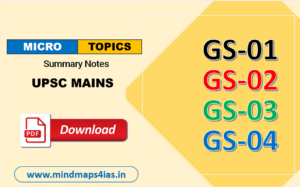- Source – The Hindu
- Link – https://www.thehindu.com/sci-tech/health/the-tobacco-epidemic-in-india/article68233803.ece
- Syllabus – GS Paper 02
- Topic – Issues Relating to Development and Management of Social Sector/Services relating to Health
What is the issue?
On the Occasion of World No Tobacco Day, it is pertinent for us to delve deeper into the case of Tobacco Epidemic in India. Through the World No Tobacco Day, WHO aims to raise awareness about the health risks of tobacco use. It also advocates for stringent measures to protect public health, especially among youth.
What is the status of Tobacco epidemic in India?
- After China, India has the world’s highest number of tobacco consumers, with nearly 26 crore tobacco users according to a 2016-17 estimate.
- The Global Adult Tobacco Survey and India’s National Family Health Survey capture the status of tobacco usage in people above 15 years of age, while the Global Youth Tobacco Survey (GYTS) assesses tobacco use in students between the ages of 13 and 15 years.
- According to all these surveys, the usage of tobacco is increasing in India.
- Additionally, India has the largest number of smokeless tobacco users in the world, accounting for 66% of the world’s smokeless tobacco users.
What are the negative impacts of tobacco epidemic in India?
- Tobacco usage has a deleterious impact on human health, causing a wide range of life-threatening diseases like cancer.
- According to the WHO, tobacco use is a major cause of death and disease in India, responsible for an estimated 35 million deaths annually.
- The health of more than 60 lakh people employed in the tobacco industry is also at risk due to the absorption of tobacco through the skin, causing various diseases.
- The economic loss to India due to tobacco’s effects on consumer health was over ₹1.7 lakh crore in the fiscal year 2017-2018, which is approximately three times the Union health budget of around ₹48,000 crore, according to a 2021 study.
- Additionally, the deterioration of soil quality is a significant concern, as the tobacco crop is highly erosive and rapidly depletes soil nutrients, necessitating increased fertilizer usage that further worsens soil quality.
- Deforestation is another critical issue, with approximately 4 kg of wood required to process 1 kg of tobacco.
- The production and consumption of tobacco generate around 7 lakh tonnes of waste annually in India, and cleaning up this waste costs an estimated ₹6,367 crore each year.
- Furthermore, tobacco smoking violates non-smokers’ right to clean air, undermining their health, and impacts household welfare as the expenses incurred in tobacco use substitute the basic needs of food and education among disadvantaged populations.
What are the Govt Schemes and initiatives for Tobacco Control in India?
- Cigarettes Act 1975: Limited to statutory warnings like ‘Cigarette Smoking is Injurious to Health’ on cigarette packs and advertisements; did not include non-cigarettes.
- COTPA 2003: Contains 33 sections governing the production, advertisement, distribution, and consumption of tobacco in India.
- WHO’s Framework Convention on Tobacco Control: India, one of 168 signatories since 2005, aims to reduce tobacco usage globally by developing demand and supply reduction strategies.
- Food Safety and Standards Act 2006: Prohibits the use of tobacco or nicotine as ingredients in food products.
- Cable Television Networks Amendment Act 2000: Prohibited the transmission of tobacco and liquor advertisements in India.
- Prevention and Control of Pollution Act 1981: Recognized smoking as an air pollutant.
- Motor Vehicles Act 1988: Made smoking illegal in public vehicles.
- National Tobacco Control Programme (NTCP) 2008: Aims to control tobacco consumption and minimize related deaths through training, IEC activities, surveys, and tobacco cessation.
- Tobacco Cessation: Provides targeted support and has established clinics across the country to help people quit tobacco use.
- Tobacco Taxation: According to the WHO Report on the Global Tobacco Epidemic 2017, India has some of the highest cigarette taxes in the world. Cigarettes face high and discriminatory taxation compared to other tobacco products. In 2014-15, the government collected 87% of its total tobacco revenue from legal cigarettes.
What are the Challenges with Tobacco Control Programmes in India?
- Ineffective regulatory coverage has resulted in non-compliance of smokeless tobacco products (SLTs) with COTPA packaging guidelines and poorly regulated smuggled tobacco products.
- Outdated provisions in COTPA, such as the unchanged ₹5,000 fine since 2003 for packaging violations, hinder its effectiveness.
- Unclear guidelines on surrogate and indirect advertisements allow proxy products like Elaichi to indirectly promote tobacco, as seen in the ICC Men’s Cricket World Cup 2023.
- Ineffective implementation of NTCP is evident from a 2018 study showing no significant reduction in bidi or cigarette consumption between NTCP and non-NTCP districts, due to insufficient staffing, resource allocation, and monitoring.
- Tax evasion undermines excise duty efforts, with practices like purchasing in lower tax jurisdictions and illicit methods such as smuggling and counterfeiting.
- The increasing affordability of tobacco products is due to low taxes not keeping pace with rising incomes, as a 2021 BMJ study reported cigarettes, bidis, and SLTs have become more affordable over the past decade, exacerbated by the GST regime.
- Government interference in the tobacco industry has worsened India’s score on the tobacco interference index, with officials engaging with the industry and the government holding a 7.8% stake in ITC Ltd., India’s largest tobacco company.
What needs to be done?
- Effective regulations on surrogate advertisements are crucial, necessitating updates to COTPA to include regulations on surrogate advertisements, expand the definition of ‘advertisement’ to cover films and video games, and increase fines for violation of advertisement norms by a factor of 10.
- Increasing tax on tobacco products in alignment with FCTC recommendations is essential, with current taxes at 51% for cigarettes, 22% for bidis, and 64% for SLTs needing to be raised to 75% as recommended.
- Strict implementation of the Prohibition of Electronic Cigarette Act (PECA), 2019 is necessary, emphasizing strengthened governance frameworks, reduced corruption, and enhanced effectiveness of customs and tax administration.
- Encouraging tobacco farmers to switch to alternate crops is vital to mitigate livelihood loss, supported by findings from the Central Tobacco Research Institute indicating higher net returns from crops like jowar compared to tobacco for large-scale farmers.
















